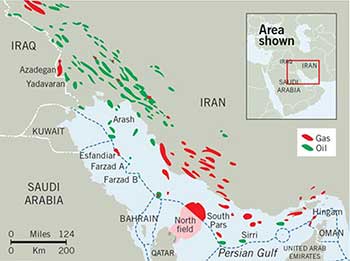Daily-current-affairs
/
18 Oct 2020
Farzad–b Gas Field: Loose Foot in India - Iran Relation : Daily Current Affairs

Farzad–b Gas Field: Loose Foot in India - Iran Relation
IN NEWS
- India has all but lost the ONGC Videsh Ltd-discovered Farzad-B gas field in the Persian Gulf after
Iran decided to prefer domestic companies over foreign firms for development of the field.
ABOUT
- ONGC Videsh Ltd (OVL), the overseas investment arm of state-owned Oil and Natural Gas Corp
(ONGC), had in 2008 discovered a giant gas field in the Farsi offshore exploration block. OVL and
its partners had offered to invest up to $11 billion for development of the discovery, which was
later named Farzad-B.
- Farzad-B holds total reserves of around 21.7 trillion cubic feet of which around 60 per cent is
recoverable, and production is slated to be around 1.1 billion cubic feet per day.
- The 3,500 square kilometre Farsi block sits in water depth of 20-90 metres on the Iranian side of
the Persian Gulf.
- From the economic perspective, Iran is the second largest supplier of crude oil to India,
supplying more than 425,000 barrels of oil per day, and consequently India is one of the largest
foreign investors in Iran's oil and gas industry.
- While India’s policy makers have been tomtomming the geostrategic implications of the Indo-
Iranian collaborative Chabahar port project, Farsad-B Gas field is almost gone.
INDIA–IRAN RELATION
- India-Iran relations span millennia marked by meaningful interactions. The two countries shared
a border till 1947 and share several common features in their language, culture and traditions.
- Indian subcontinent and the Persian Gulf have strong commercial, energy, cultural and people-
to-people links. India and Iran established diplomatic links on March 15, 1950. In addition to the
Embassy in Tehran, India has two Consulates in Iran, one in Bandar Abbas and other in Zahedan.
- Before the Iranian Revolution of 1979, the Shah of Iran visited India twice (March 1956 and
February 1978) and Prime Minister Jawaharlal Nehru visited Iran in 1963.
- The trend was enhanced at the turn of the millennium with the visit of Prime Minister Shri Atal
Bihari Vajpayee to Tehran in April 2001 wherein the two countries signed the “Tehran
Declaration” which set forth the areas of possible cooperation between the two countries.
President Mohammad Khatami visited India from January 24-28, 2003 as the Chief Guest at the
Republic Day parade. Both sides signed “The New Delhi Declaration” which set forth the vision
of strategic partnership between India and Iran.
CHABAHAR PORT
- Chabahar Port is a seaport in Chabahar located in southeastern Iran, on the Gulf of Oman. It
serves as Iran's only oceanic port, and consists of two separate ports named Shahid Kalantari
and Shahid Beheshti, each of which has five berths.
COMMERCIAL RELATIONS
- The India-Iran bilateral trade during the fiscal year 2018-19 rose to USD 17.03 billion as
compared to USD 13.76 billion in 2017-18. This represents an increase of 23.8%. The value of
India’s exports stood at USD 3.5 billion and imports from Iran were USD 13.5 billion. Major
Indian exports to Iran include rice, tea, iron and steel, organic chemicals, metals, electrical
machinery, drugs/pharmaceuticals, etc. Major Indian imports from Iran include petroleum and
its products, inorganic/organic chemicals, fertilizers, plastic and articles, edible fruit and nuts,
glass and glassware, natural or cultured pearls, precious or semiprecious stones, etc.
CONNECTIVITY
- During the visit of Prime Minister Shri Narendra Modi to Tehran in May 2016, the contract on
Chabahar was signed which, inter-alia, comprises investment of $85 million for equipping the
port. The contract also comprises of provision of credit of approximately USD 150 million for the
development of the 1st Phase of Shahid Beheshti port at Chabahar.
INDIAN COMMUNITY
- The Indian community in Iran comprises of around 4000 Indian nationals. (This includes 80- 100
families in Tehran and 13-15 families in Zahedan. There are approx. 2800 Indian nationals in
Qom, Esfahan and Mashhad consisting of Indian students undergoing theological studies and
their family members.
- There are also around 200 Indian nationals working in private companies in Iran). There is an
Indian school in Tehran run by the Kendriya Vidyalaya Sangathan (KVS) under the aegis of
Embassy of India.
IRAN’S DIPLOMATIC PRESENCE IN INDIA
- Iran has its Embassy in New Delhi. In addition, Iran has two Consulates General in Mumbai and
Hyderabad and two Cultural Centres in New Delhi and Mumbai.
CONCLUSION
- India’s stakes in Chabahar remain strong, and no matter who builds the railway line, Indian
trade could still find its way to Afghanistan and Central Asia. India’s monetary losses are minimal
in farzad–b gas field, as it had not invested money or material yet.
- Tehran has to recognize that New Delhi has partners in the region and beyond with whom the
stakes are much higher. Yet, India has been consistent in its support for Iran and its ambitions.
Managing bilateral relations is not India’s responsibility alone. If Iran decides that India is
dispensable, New Delhi can also easily make a similar calculation. There will be costs for India,
for sure, but the costs for Iran might be much higher.







